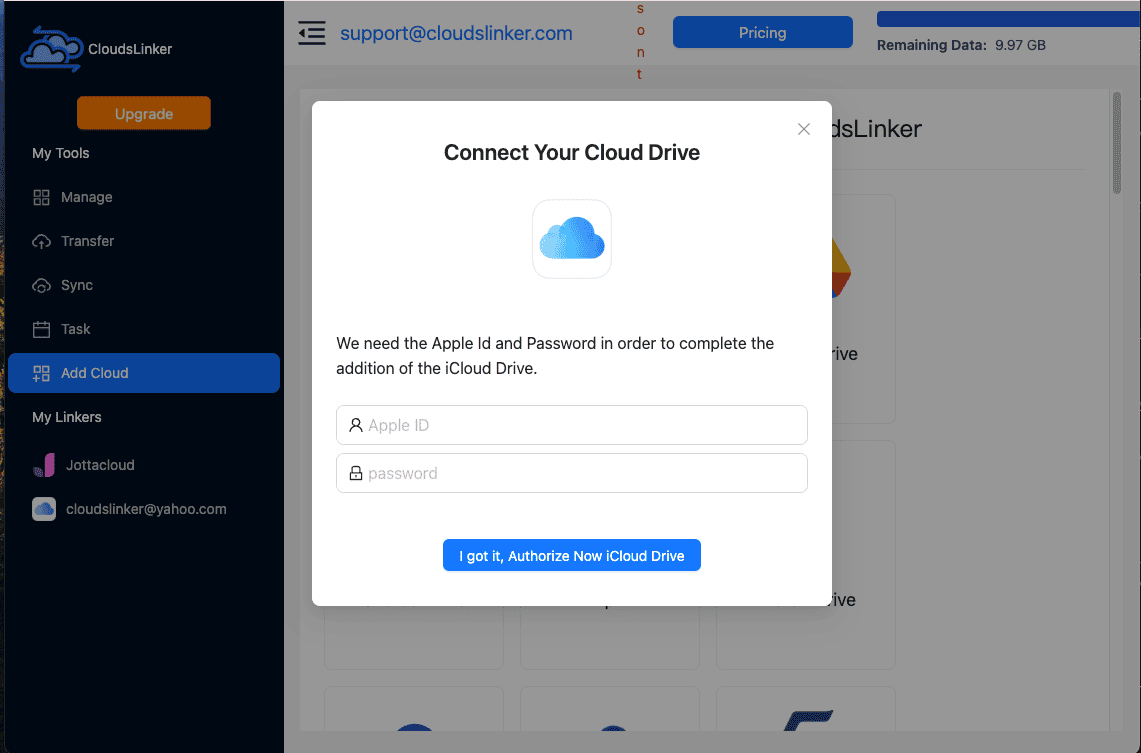4 Easy Ways to Transfer Files from iCloud Drive to OneDrive (2025)
Moving files from iCloud Drive to OneDrive doesn't have to be difficult. This guide walks you through four reliable methods—from simple manual uploads to fully automated cloud-to-cloud transfers—so you can migrate your data efficiently without stress or wasted bandwidth.
Introduction
As more users rely on multiple cloud platforms to store and organize their files, the need to transfer data between services like iCloud Drive and OneDrive has become increasingly common. Whether you're switching to a Microsoft-based ecosystem, centralizing your storage, or seeking better collaboration with Office tools, knowing how to migrate your files properly is essential. In this guide, we’ll walk you through four practical methods to transfer files from iCloud Drive to OneDrive—from basic web-based options to powerful tools like Rclone and fully cloud-hosted platforms like Cloudslinker. No matter your experience level or file size, you'll find a method that fits your needs.
iCloud is Apple’s seamless cloud platform that keeps photos, files, backups and more synced across macOS, iOS, and Windows. Users get a base of 5 GB free, which can be upgraded up to 12 TB via iCloud+
- Desktop & Documents Sync: Automatically syncs your Mac Desktop and Documents folder, editable on iPhone, iPad, or iCloud.com
- Up to 50 GB uploads: Supports large files—great for HD video or design assets
- Cross-device access: Access via Finder (Mac), Files (iOS), File Explorer (Windows), or browser
- Collaboration & Sharing: Create custom folders, share with others in real time, comment/edit documents .
- Deep Apple ecosystem integration: Works with Photos, Mail, Contacts, Safari, Keychain, Find My, and more—all encrypted end‑to‑end with optional Advanced Data Protection.
OneDrive is Microsoft’s cloud storage solution, offering 5 GB free, or up to 1 TB+ with a Microsoft 365 subscription—best suited for Windows and Office users .
- Files On‑Demand: Browse files in File Explorer without occupying disk space; download only what you need .
- Automatic Backup: Sync critical folders (Desktop, Documents, Pictures) across devices automatically.
- Versioning & Restore: Keep up to 30 days of version history, undo unwanted changes easily .
- Secure File Sharing: Share via modern attachments in Outlook or links with granular permissions; business plans include policy controls .
- Copilot AI integration: Ask questions, generate file summaries, compare documents, and more—right within OneDrive
- Cross-platform support: Available as an OS‑integrated folder in Windows, macOS, iOS, Android, plus web; mobile apps offer photo scanning and whiteboard capture .
- Enhanced Search & UX: New search filters, colored folders, improved mobile experience and future AI-powered features .
Moving your files from iCloud Drive to OneDrive offers significant advantages—especially if you're using both Apple and Windows devices or frequently collaborate using Microsoft Office apps.
- Seamless Windows Integration: OneDrive integrates directly with Windows File Explorer and Office apps, allowing easy file management and automatic saving to the cloud.
- Robust Versioning & Restore: OneDrive maintains a version history for 30 days, letting you easily recover previous file versions or restore deleted items from the Recycle Bin.
- Superior Office Collaboration: Real-time co-authoring of documents using Word, Excel, and PowerPoint facilitates seamless teamwork and productivity.
- Files On-Demand: Access your cloud files without consuming local storage, downloading only those files you need to work with at any moment.
- Enterprise-Grade Security: OneDrive secures your files with encryption in transit and at rest (TLS + AES-256), along with two-factor authentication for enhanced protection.
- Microsoft 365 Benefits: Subscribers gain substantial storage—1 TB for personal plans, up to 6 TB for family plans—combined with premium Office applications, delivering exceptional value.
- Cross-Platform Support: OneDrive apps are available on Windows, macOS, iOS, Android, and the web, providing consistent access and functionality across devices.
Whether you're integrating Apple devices with a Windows environment, leveraging Microsoft’s productivity tools, or seeking robust file versioning and collaboration features, OneDrive stands out as a powerful alternative to iCloud Drive.
Before you start moving files, let's quickly compare iCloud Drive and OneDrive. While both platforms offer reliable cloud storage, their strengths suit different kinds of users and workflows.
| Feature | iCloud Drive | OneDrive |
|---|---|---|
| Free Storage | 5 GB | 5 GB |
| Platform Integration | Optimized for Apple devices (macOS, iOS) | Optimized for Windows; robust on macOS, iOS, Android |
| Collaboration Capabilities | Great for Apple apps (Pages, Numbers, Keynote) | Excellent with Microsoft Office (Word, Excel, PowerPoint) |
| Third-Party Integration | Limited third-party support | Extensive integrations (Teams, Slack, Trello, Zoom) |
| File Versioning & Backup | Basic file recovery features | Advanced file versioning and restoration up to 30 days |
| Security Features | Strong encryption, best suited for personal use | Enterprise-level security, encryption, and 2FA |
iCloud Drive is ideal if your workflow primarily revolves around Apple devices and software. However, if you’re looking for powerful collaboration, strong security, and excellent cross-platform flexibility—especially within a Microsoft environment—OneDrive becomes the clear winner.
Before you start migrating, it's helpful to first review what's stored in your iCloud Drive. Check how much storage you've used and the type of files you have, so you can determine if the free OneDrive storage will suffice, or if upgrading to a premium Microsoft 365 plan is necessary.
Also, ensure you've got a Microsoft account set up beforehand. If you don't have one yet, signing up at signup.live.com only takes a minute. A Microsoft account doesn't just unlock OneDrive—it also gives you access to the entire suite of productivity apps like Word, Excel, PowerPoint, and Teams, helping you transition smoothly and boosting your overall productivity.
Method 1: Transfer via Web Browsers
Step 1: Download Files from iCloud Drive
Begin by heading to the official iCloud Drive page and signing in with your Apple ID credentials. Once
logged in, browse through your folders to find the files you want to migrate. You can select multiple items
by holding down the Command (Mac) or Ctrl (Windows) key while clicking.
To download, simply click the cloud-shaped download icon in the top bar. If you’re downloading an entire folder, iCloud will package it as a ZIP file. After downloading, don’t forget to unzip the file on your computer so it’s ready for upload.

Step 2: Upload Files to OneDrive
Now go to OneDrive and log in with your Microsoft account. Once you're in, click the "Upload" button at the top or drag files and folders directly into the web interface. You can choose either Files or Folder, depending on what you're uploading.
Make sure everything is organized as you want it—OneDrive allows you to create new folders, rename files, and even move items after upload for better structure.

This browser-based method is straightforward and doesn’t require any extra tools—perfect for light users or occasional transfers. But if you're dealing with large files or multiple folder structures, the manual download-and-upload cycle can become time-consuming and prone to error. For those situations, you might want to consider using automated tools or cloud-to-cloud services.
Method 2: Transfer with iPhone
Step 1: Open OneDrive App and Choose to Upload
On your iPhone, open the OneDrive app and log in with your Microsoft account. Tap the “+” icon, usually located at the top or bottom of the screen depending on your version. From the menu, select “Upload”, then tap “Browse” to open the iOS file system.

Step 2: Select Files from iCloud Drive
You’ll now see the familiar Files app interface. Head to the “iCloud Drive” section to locate the files or folders you'd like to upload. iOS may take a moment to download any files that aren’t already stored locally on your device. Once they're ready, OneDrive will begin uploading them to your cloud storage.

This method is particularly convenient for iPhone users who want to transfer files without needing a computer. It’s ideal for quick, on-the-go uploads—whether you're saving documents, photos, or PDFs from iCloud Drive into OneDrive. Just keep in mind that large transfers or complex folder structures might require more time and repeated actions.
Method 3: Command-Line Transfer with Rclone
Step 1: Install Rclone and Set Up Your Accounts
For users who are comfortable using the terminal, Rclone offers a robust way to move files from iCloud Drive to OneDrive with efficiency and precision. Start by installing Rclone on your macOS, Windows, or Linux machine.
Once installed, launch the interactive setup by running:
rclone config. You'll be asked to configure both the source and destination remotes:
- iCloud Drive (Local Sync Folder): Typically located at
~/Library/Mobile Documents/com~apple~CloudDocson macOS. - OneDrive: Select OneDrive from Rclone's remote options and follow the OAuth login instructions in your browser to authorize access.

Step 2: Start the File Transfer
Once both remotes are configured, you're ready to move your data. Use a command like this to begin copying files:
rclone copy "~/Library/Mobile Documents/com~apple~CloudDocs" onedrive:MyBackup --progress
This command will copy all contents from your local iCloud Drive folder to the MyBackup
directory in OneDrive. Want to test things first? Add --dry-run to simulate the transfer
without moving any files.

Rclone is an excellent choice for users who want full control over their transfer process. You can schedule recurring syncs, exclude certain files, or integrate with automation scripts. It does, however, require basic knowledge of command-line operations and some initial configuration effort.
Method Four: Cloud Transfer via Cloudslinker
Overview: iCloud Drive to OneDrive with Cloudslinker
Cloudslinker is a
cloud-to-cloud transfer platform that supports over 40 cloud services, including
iCloud Drive and OneDrive. Transfers run entirely in the cloud—no need
to download or upload files manually. It’s fast, bandwidth-free, and suitable for one-time migrations or
recurring syncs.
Step 1: Sign in to Cloudslinker
Visit app.cloudslinker.com and log into your Cloudslinker account. On the left sidebar, click “Add Cloud” to connect your drives. First, choose OneDrive and follow the on-screen OAuth prompts to grant access. Your login credentials are never stored—only authorized tokens are used.

Unlike most services, a single Microsoft account might contain access to multiple OneDrive cloud disks (such as personal and business drives). Once authenticated, Cloudslinker will display all available drives linked to your account—you simply choose which one to add.

Step 2: Connect iCloud Drive
Next, select iCloud Drive from the list and log in using your Apple ID and password. If two-factor authentication is enabled, you’ll be prompted to enter the 6-digit code sent to your Apple device. After verification, your iCloud Drive will be successfully linked.

Step 3: Set Up the Transfer
Open the Transfer tab. Select iCloud Drive as your source and choose the folder or files you wish to move. Then, select your preferred OneDrive target location. You can preview both drives before initiating the migration.

Need more control? You can apply filters based on file extensions, size, or modified date. For example,
exclude .DS_Store files or skip videos over 2 GB. These options are available under
“Advanced Settings.”

For recurring needs, you can schedule transfers daily, weekly, or at custom intervals. This is especially useful for ongoing sync between workspaces. Learn more in our scheduling tutorial.

Step 4: Track Progress in Real Time
Once the transfer begins, monitor status in the Task List. Here you’ll see real-time progress, estimated completion time, and logs. Tasks can be paused or retried at any point. Partial failures (e.g. due to unsupported formats) are automatically recorded for manual follow-up.
Step 5: Verify Completion
After the process finishes, you'll receive a completion message along with a report of what was transferred and what may have failed. Your iCloud Drive data is now safely housed in OneDrive.
Cloudslinker is a top choice for hassle-free, browser-based file migrations. With support for OAuth, transfer filters, schedule automation, and real-time task control, it provides both simplicity and power—no installation needed.
Need to Migrate from Other Clouds?
Cloudslinker also supports Google Drive, Dropbox, pCloud, Box, MEGA, and many more. No matter what your workflow looks like, you can consolidate or distribute your data with ease.
Comparison of the Four Methods
Each method for transferring files from iCloud Drive to OneDrive has its own strengths and trade-offs. The right choice depends on your comfort level with technology, the size of your data, and whether you prefer speed or control. Below is a breakdown of each method to help you decide:
| Method | Ease of Use | Speed | Best For | Requires Local Bandwidth | Technical Skill |
|---|---|---|---|---|---|
| Web Browser (Manual) | ★★★★★ | ★★★☆☆ | Small or one-time transfers | Yes | Beginner |
| iPhone Upload via App | ★★★★★ | ★★★☆☆ | Mobile users needing quick uploads | Yes | Beginner |
| Command-Line (Rclone) | ★★☆☆☆ | ★★★★★ | Advanced users, automation tasks | Yes | Advanced |
| Cloudslinker (Cloud-Based) | ★★★★★ | ★★★★★ | All users, any file size, full automation | No | Beginner |
If you’re transferring just a few files and don’t mind doing it manually, the browser or iPhone method is a good place to start. Rclone is great if you’re tech-savvy and need advanced control or automation. But if you want the fastest, most convenient solution—without using any of your local network bandwidth—Cloudslinker is the clear winner. Everything runs in the cloud, so your transfers continue even if you shut down your device.
Transferring files from iCloud Drive to OneDrive is typically smooth—but a few key details can help prevent delays, errors, or frustration during the process:
- Files Not Fully Synced: If you’re using manual or desktop-based tools, ensure all files in iCloud Drive have been downloaded locally. Files marked as cloud-only can cause errors or incomplete uploads.
- Microsoft OneDrive API Limits: OneDrive has upload limits per file and bandwidth caps depending on account type. Cloud-based tools like Cloudslinker can handle retries and resumptions automatically when limits are reached.
- Transfer Speed: Manual methods depend entirely on your local internet speed. In contrast, Cloudslinker operates server-to-server, offering dramatically faster performance without using your home or office bandwidth.
- Check OneDrive Storage: Make sure your OneDrive account has enough available storage to accommodate the incoming data. Microsoft 365 plans offer up to 1TB or more.
- Use Secure Tools: Always use transfer tools that support OAuth login and end-to-end encryption. Cloudslinker uses secure tokens and AES-256 encryption, and never stores your account credentials.
- Planning Large Transfers: Migrating hundreds of gigabytes or even terabytes? Choose a tool that supports automatic retries, task logs, and scheduling. Cloudslinker allows large migrations to run in the background, even if you shut down your device.
Keep these tips in mind to avoid unexpected issues and ensure your iCloud to OneDrive migration is as seamless as possible—especially when dealing with large file sets or limited local resources.
Frequently Asked Questions
Watch Our Step-by-Step Video Tutorial
Learn how to transfer files from iCloud Drive to OneDrive with our clear, visual walkthrough. This tutorial is perfect for anyone—whether you're new to cloud storage or just looking for the easiest method. We’ll guide you through every step, from accessing your files in iCloud to syncing them with OneDrive using various tools including Cloudslinker. Get expert tips, avoid common mistakes, and simplify your cloud migration process. Watch now and move your files with confidence!
Conclusion
We've covered four effective ways to transfer files from iCloud Drive to OneDrive—each designed for different scenarios. If you prefer hands-on control, the web and iPhone methods offer simplicity. If you need automation or work with large data sets, Rclone and Cloudslinker provide speed and flexibility. In particular, Cloudslinker stands out for its server-to-server performance, avoiding any local bandwidth usage and allowing transfers to continue even if your device is offline. By selecting the approach that fits your workflow, you can streamline your file management and keep your cloud storage organized across platforms.
Online Storage Services Supported by CloudsLinker
Transfer data between over 44 cloud services with CloudsLinker
Didn' t find your cloud service? Be free to contact: [email protected]
Further Reading
Effortless FTP connect to google drive: Transfer Files in 3 Easy Ways
Learn More >
Google Photos to OneDrive: 3 Innovative Transfer Strategies
Learn More >
Google Photos to Proton Drive: 3 Effective Transfer Techniques
Learn More >











































